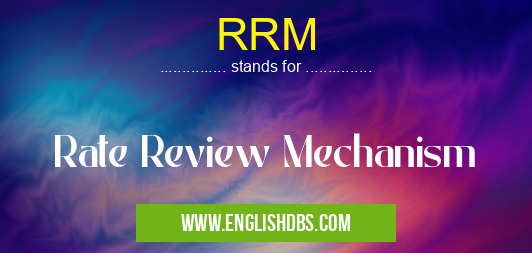What does RRM mean in UNCLASSIFIED
RRM (Rate Review Mechanism) is a regulatory framework established to periodically review and adjust electricity tariffs to ensure fair pricing for both consumers and electricity utilities. It aims to strike a balance between the interests of stakeholders, promoting affordability for consumers while maintaining the financial viability of utilities.

RRM meaning in Unclassified in Miscellaneous
RRM mostly used in an acronym Unclassified in Category Miscellaneous that means Rate Review Mechanism
Shorthand: RRM,
Full Form: Rate Review Mechanism
For more information of "Rate Review Mechanism", see the section below.
Components of RRM
- Regular Tariff Reviews: Tariffs are subject to periodic reviews to assess their relevance and adequacy. The frequency of reviews varies depending on the specific RRM framework.
- Independent Review Body: An independent body, such as a regulatory commission, typically conducts the tariff reviews. This body ensures objectivity and impartiality in the review process.
- Stakeholder Engagement: All affected stakeholders, including consumers, utilities, and other industry players, are provided with opportunities to participate in the review process and present their views.
- Cost Analysis: The review body analyzes the costs incurred by utilities, including fuel, generation, transmission, and distribution expenses. It assesses the reasonableness of these costs and determines the appropriate tariff rates.
- Tariff Adjustment: Based on the review findings, the independent body may adjust the electricity tariffs to ensure fair pricing and financial sustainability. This adjustment process typically involves public consultation and approval.
Benefits of RRM
- Fair Pricing: RRM ensures that electricity tariffs are set at a level that reflects the actual costs incurred by utilities while protecting consumers from excessive charges.
- Transparency: The review process is transparent, allowing stakeholders to understand the basis for tariff adjustments.
- Investment Incentive: By providing a framework for regular tariff adjustments, RRM encourages utilities to invest in efficient infrastructure and adopt cost-effective practices.
- Market Stability: RRM contributes to the stability of the electricity market by ensuring that tariffs are aligned with market conditions and evolving costs.
Essential Questions and Answers on Rate Review Mechanism in "MISCELLANEOUS»UNFILED"
What is a Rate Review Mechanism (RRM)?
An RRM is a provision in a contract that allows for the periodic review and adjustment of a specified rate, such as a price, fee, or tariff. It is typically used to ensure that the rate remains fair and equitable over the course of the contract.
Why are RRMs used?
RRMs are used to address potential changes in market conditions, costs, or other factors that may affect the fairness of the original rate. They allow parties to adjust the rate based on objective criteria to avoid disputes or dissatisfaction.
What are the key components of an RRM? A: An RRM typically includes the following components: - Trigger event: The specific event or condition that initiates the rate review process. - Review process: The steps involved in conducting the review, including data collection and analysis. - Adjustment formul
An RRM typically includes the following components:
- Trigger event: The specific event or condition that initiates the rate review process.
- Review process: The steps involved in conducting the review, including data collection and analysis.
- Adjustment formula: The method used to calculate the new rate based on the review findings.
- Implementation timeline: The timeframe for implementing the adjusted rate.
Who is responsible for conducting the rate review?
The responsibility for conducting the rate review can vary depending on the terms of the contract. It may be performed by an independent third party, a regulatory body, or a joint committee representing both parties.
What are the advantages of using an RRM?
An RRM provides several advantages, including:
- Ensuring fairness and transparency in rate adjustments.
- Reducing the risk of disputes or litigation.
- Allowing parties to adapt to changing market conditions.
- Maintaining a mutually acceptable balance between the interests of the parties.
Final Words: RRM is an essential framework that safeguards the interests of consumers and electricity utilities by ensuring fair pricing and financial sustainability. Through regular tariff reviews and stakeholder engagement, RRM promotes transparency and accountability in the electricity sector. By balancing the need for affordable electricity with the financial viability of utilities, RRM contributes to a stable, efficient, and equitable electricity market.
RRM also stands for: |
|
| All stands for RRM |
